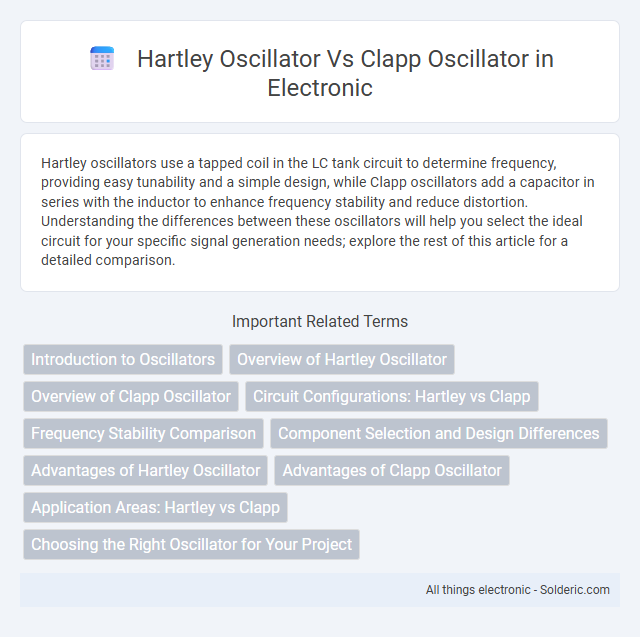Hartley oscillators use a tapped coil in the LC tank circuit to determine frequency, providing easy tunability and a simple design, while Clapp oscillators add a capacitor in series with the inductor to enhance frequency stability and reduce distortion. Understanding the differences between these oscillators will help you select the ideal circuit for your specific signal generation needs; explore the rest of this article for a detailed comparison.
Comparison Table
| Feature | Hartley Oscillator | Clapp Oscillator |
|---|---|---|
| Oscillator Type | LC Oscillator | LC Oscillator |
| Tuned Circuit | Series tank with tapped inductors | Series tank with additional capacitor (Clapp capacitor) |
| Frequency Stability | Moderate | High |
| Frequency Determining Components | Inductors and capacitor | Capacitors and inductor |
| Feedback Mechanism | Inductive feedback via tapped coil | Capacitive feedback via series capacitor |
| Tuning Range | Wide | Narrower but more stable |
| Typical Application | Low frequency to mid frequency oscillations | High frequency oscillations with precision |
| Complexity | Simple design | More complex due to extra capacitor |
Introduction to Oscillators
Hartley oscillator and Clapp oscillator are both types of LC oscillators used to generate sinusoidal waveforms. The Hartley oscillator uses a tapped coil or two inductors in series with a single capacitor to determine the frequency, providing simplicity and ease of tuning. The Clapp oscillator improves frequency stability by adding a capacitor in series with the inductor, making it more suitable for applications requiring precise and stable oscillations.
Overview of Hartley Oscillator
Hartley oscillators utilize a tapped inductor or two inductors in series with a capacitor to produce sinusoidal oscillations, relying on inductive feedback for frequency determination. This design offers simplicity and ease of tuning, making it suitable for radio frequency applications. The frequency of oscillation is primarily set by the inductance and capacitance in the tank circuit, allowing stable and low-distortion waveform generation.
Overview of Clapp Oscillator
The Clapp oscillator is an improved version of the Hartley oscillator, featuring a capacitor added in series with the inductor in the tank circuit, which enhances frequency stability. It operates at high frequencies with reduced phase noise due to better frequency control from the additional capacitor, compared to the Hartley design that uses a tapped inductor. The Clapp oscillator's precise frequency tuning and low distortion make it ideal for applications requiring stable sinusoidal output signals.
Circuit Configurations: Hartley vs Clapp
The Hartley oscillator features a tank circuit with a tapped inductor or two inductors in series paired with a single capacitor, providing frequency control primarily through the inductance ratio. In contrast, the Clapp oscillator modifies this configuration by adding a capacitor in series with the inductor, enhancing frequency stability and tuning precision. Your choice between the two circuits depends on the desired frequency stability and tuning accuracy for your oscillator design.
Frequency Stability Comparison
The Clapp oscillator offers superior frequency stability compared to the Hartley oscillator due to its fixed capacitor in the tank circuit, which reduces the impact of component variations and parasitic capacitances. Hartley oscillators rely on variable inductors, making them more susceptible to frequency drift caused by temperature changes and coil inductance fluctuations. For your applications requiring precise frequency control, the Clapp oscillator is generally the preferred choice.
Component Selection and Design Differences
Hartley oscillators use a tapped inductor or two inductors in series alongside a capacitor to set the resonance frequency, emphasizing inductive component selection for frequency stability. Clapp oscillators replace the single capacitor in the Hartley design with three capacitors, including a series capacitor that improves frequency accuracy and reduces dependency on inductor tolerances. Your choice between these two depends on the required frequency precision and the availability of high-quality inductors or capacitors in your design.
Advantages of Hartley Oscillator
Hartley oscillator offers simplicity in design with fewer components, making it cost-effective and easier to tune. It provides a wide frequency range and stable oscillations due to its LC tank circuit configuration. Your circuit benefits from better frequency stability and lower harmonic distortion compared to other oscillators like the Clapp oscillator.
Advantages of Clapp Oscillator
The Clapp oscillator offers superior frequency stability compared to the Hartley oscillator due to its fixed capacitor in series with the inductor, which minimizes the effect of transistor parameters and stray capacitances on oscillation frequency. It provides better amplitude stability and lower phase noise, making it ideal for high-frequency applications. The Clapp design also allows easy frequency tuning and improved selectivity, enhancing overall performance in precision signal generation.
Application Areas: Hartley vs Clapp
Hartley oscillators are widely used in RF signal generation and tuning circuits due to their simple design and ease of frequency adjustment, making them ideal for low-frequency applications such as audio oscillators and local oscillators in receivers. Clapp oscillators, preferred for high-frequency stability and low phase noise, dominate applications in precision frequency synthesis, microwave signal generation, and communication systems requiring superior frequency accuracy. While Hartley oscillators excel in general-purpose and low-frequency domains, Clapp oscillators are favored in high-frequency and high-performance scenarios.
Choosing the Right Oscillator for Your Project
Selecting the appropriate oscillator depends on frequency stability and tuning range requirements, with the Hartley oscillator offering simplicity and ease of tuning through its tapped coil design, ideal for lower-frequency applications. The Clapp oscillator provides superior frequency stability and lower phase noise due to its additional capacitor in the tank circuit, making it suitable for high-frequency and precision applications. Evaluating factors like component tolerance, thermal stability, and desired signal purity helps determine whether the Hartley or Clapp oscillator best fits your project's performance criteria.
hartley oscillator vs clapp oscillator Infographic

 solderic.com
solderic.com